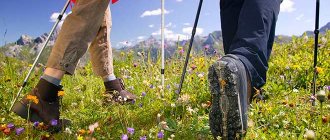Types of walking
There are many healthy walking methods, most of them do not require additional equipment and work with the trainee’s own body weight. Considering that a person walks about 4-5 km per hour at a calm, even pace, it is health-improving methods that involve increasing the speed of movement.
Scandinavian
Another name for the method is Finnish walking (Nordic Walking), first described by Finnish specialists in training skiers in the summer. This method requires special equipment - suitable shoes and poles, like ski poles, but shorter and heavier. Walking with poles involves additional stress on the muscles of the arms and upper body and a wider range of movements. The special design of the fastenings in the form of gloves with cut off fingers allows you not to squeeze the handle of the stick, but to lean on it and help you push off the ground. The poles are selected individually and make up about 66-68% of the trainee’s height. The use of sticks allows you to more functionally distribute the load on the spine and joints of the limbs, the risk of injury is minimal. The speed of movement can be different - from a light walking step to almost running, on average - 6 km/h.
Wellness
This method involves increasing speed to 6-8 km/h, almost twice as fast as normal walking. At this pace you need to walk for 30 to 60 minutes, without slowing down. In general, this speed allows you to talk without losing your breath. This walking is as close as possible to the limit of a person’s physiological capabilities; it does not have a special technique for performing it. For people who are overweight or have had injuries or surgeries, the usual speed of movement will be very useful, the main thing is to walk without stopping for at least half an hour.
Sports
An Olympic sport, the speed of movement is from 7 to 15 (17) km/h. Its difference from other walking methods is that the contact of the legs with the ground should be visible and constant, and the leg brought forward should not bend at the knee. The second foot is placed on the ground before the first one comes off, each step being “double-footed.” This forms a specific “gait” that looks funny from the outside, but it is the least traumatic due to the soft placement of the foot. The arms are bent at the elbows and work energetically at chest level, which allows almost all the muscles of the body to be involved in the work. Special shoes are needed that will anatomically support the arch of the foot, otherwise pain may occur. An equipped, level track without obstacles or defects is also required.
Energy
Some sources describe this method as the “Indian gait”; it is aimed not at unique physical achievements, but at a healing psychological effect. The method was first described in the books of Carlos Castaneda, who conducted anthropological studies of Indian tribes. The idea is to walk one after another, focusing on the feet of the person in front or on the ground in front of you. You need to walk silently, concentratedly, long enough and monotonously. This helps to achieve a trance state and “stop the internal dialogue,” that is, an endless stream of thoughts. Your hands should be absolutely free; additional weighting in the form of a backpack is possible. Energy walking gives a full-fledged meditative effect and energizes the trainee well.
What type of walking is beneficial?
In the era of physical inactivity and sitting at computers, any walking will be useful as opposed to inaction.
The World Health Organization recommends that a modern person walk at least 10 thousand steps per day. In fact, to improve one’s physical performance, even 5 thousand steps a day will be enough for a person, which is about 15-20 minutes of brisk walking. For some people who live in offices and travel by transport to any destination, this seems unthinkable. The habit of moving little has taken root and has become a way of life. That's why first you need to mentally tune in to introducing a new habit into your daily routine, this will create motivation. If a person cannot immediately begin intense, energetic walking or acquire special walking sticks for the Scandinavian method, this is not a reason not to walk. You need to start with small loads, increasing them as your endurance and strength grow. Key principles of healthy walking:
- regular and methodical;
- with a gradual increase in load;
- fast and quite energetic (not at a walking pace);
- taking into account the physical fitness and health status of the trainee.
How is walking beneficial for men and women?
Natural physical activity is beneficial for adults and children of all ages. However, there are significant differences in the effects of walking on men and women:
Table: effects of walking on men and women
| The effects of walking on the body | |
| In men |
|
| Among women |
|
General benefits of walking for men and women include:
- Burning excess fat. With moderate and intense walking, the layer of subcutaneous and visceral fat decreases, which has a positive effect not only on appearance, but also on the functioning of internal organs.
- Walking saturates the blood, makes it move and renew itself much faster than with a sedentary lifestyle.
- Walking strengthens bones and joints and prevents the occurrence of diseases such as osteochondrosis, arthritis and osteoporosis.
- Light physical activity helps improve mental well-being. In this case, walking accelerates the production of dopamine and, together with tone, improves mood, normalizes the emotional state, and helps to resist stress.
- Daily walking prevents cardiovascular diseases, increases the speed of metabolic processes, and removes toxins and waste from the body.
- Intense walking helps increase endurance and strength of the body.
Daily walking is aimed at improving a person’s physical and mental well-being
About other benefits of walking
How is therapeutic walking useful, does walking provide any benefit to the body, and you can learn about the achievements of walking by watching the video:
Healthy walking: difference from a simple walk
The main difference between a health workout and a walk is the intensity of physical activity. It should be slightly higher than a normal walking step, otherwise the desired effect will not be achieved. The maximum that can be achieved with normal walking is to neutralize the harm of low physical activity, that is, reduce it to zero. To reach the “plus zone” the load must be increased. Positive effects of walking:
- Increased strength and endurance.
- Reducing the percentage of fat mass, increasing muscle mass.
- Involvement of a large group of muscles at the same time.
- Strengthening the musculoskeletal system, especially the joints.
- Increased vital capacity of the lungs.
- Vascular system training.
- Increased concentration and attention.
- Increased coordination and balance.
- Calms the limbic system of the brain and minimizes stress.
Impact on the body
Despite the ease of implementation, therapeutic walking has a complex effect on human health. It improves the functioning of all body systems, from the respiratory system to the muscles of the legs. Let's highlight the main positive points:
- Normalization of respiratory function;
- Blood oxygen saturation;
- Strengthening the muscles of the limbs and body;
- Hardening;
- Increased immune defense;
- Improved coordination of movements;
- Toning the cardiovascular system;
- Increased endurance;
- Improving blood flow from the lower extremities, preventing edema;
- Activation of metabolic and energy processes;
- Weight loss;
- Increased stress resistance;
- Improved mood, psychological relief.
Thanks to such multidirectional effects, such training is prescribed for both therapeutic and preventive purposes. For healthy people, walking has a tonic and general strengthening effect, as a result of which they are less likely to suffer from viral infections and cardiovascular diseases.
Execution technique
Each type of recreational walking is performed using a specific technique described above. There are also general recommendations for performing training:
Feet
The position of the legs during health walking differs little from normal gait; it should be comfortable and physiological for the person. Any movement technique is adjusted to the anatomical features of the foot. It is necessary to ensure a seamless, smooth transition from heel to toe, without “smearing” the movement.
Posture
The back should be straight, the spine straight, and the chest straightened. All this is important for proper breathing during training: tissues need oxygen in and carbon dioxide out. With spinal defects, pain may appear in various parts, and pain can also radiate to the hip, knee and ankle joints. In this case, correction of training is necessary.
Hands
The position of your hands when walking is also as physiological as possible: first try just walking at a slow pace and notice how your hands move. Add amplitude by strengthening these movements. To increase the load, bend your elbows and perform movements at chest level.
Breath
During training, it is important to maintain a constant, even pace of movement and maintain rhythmic breathing. The initial stage of the workout lasts up to 5 minutes and is accompanied by a smooth increase in load; along with it, breathing and heart rate will accelerate and, as a result, fat burning. The amount of fat burned during any workout directly depends on your heart rate. It is not recommended to increase the intensity of exercise to the point where a person begins to choke.
An indicator of proper breathing - it is possible to talk at this pace, but there is no time for talking, and it is difficult to sing.
But the regularity can be controlled in two modes: inhale for 3 steps - exhale for 3, inhale for 4 steps - exhale for 6 steps. Control your breathing with abdominal movements: while inhaling, inflate your stomach a little, while exhaling, pull it in a little.
How to do therapeutic walking correctly
It is best to start moving at a slow pace.
At a slow walking pace, a person with average physical fitness takes from 60 to 80 steps per minute.
The average pace of movement corresponds to 80 to 100 steps taken within one minute.
A fast pace is 100 or more steps completed within a minute. This indicator is individual, and it is recommended to move in the most comfortable mode for yourself .
For people with poor physical fitness, it is recommended to gradually increase the walking duration from 10 minutes to 1 hour.
For people complaining of back pain, the first days of the health path are recommended to be spent in an orthopedic corset , a bandage or other fixing devices designed to relieve the load on the spine. After about 10 days, according to your health and the doctor’s recommendations, you can already go out on the health path without these devices.
It is recommended to combine breathing with the pace of walking: at steps 2 and 4, inhale, at steps 3 and 5, exhale. But this indicator, of course, is purely individual. If your breathing is lost , it is recommended to make a short stop, restore your breathing rhythm and only then continue moving. While stopping, you can do flexibility exercises and leg relaxation exercises.
It is recommended to travel the uphill sections of the route at a very slow, slow and medium pace. Even if you don’t feel tired while moving, it’s still better to stop.
How many calories can walking burn?
Walking is not the most energy-intensive sport; in terms of the number of calories burned, it is significantly inferior to other types of training. This should not become an obstacle for those who want to lose weight by walking, and without strain and exhausting exercises.
This is interesting: the fat-burning effect of walking can be greatly enhanced. To do this, you need to wake up a little earlier in the morning, eat nothing, drink enough water ( never drink tea or coffee with sugar ), get dressed and go for an energetic walk for 30 minutes.
During such walking on an empty stomach, the body will burn a large amount of fat because it is in a state of hunger.
In 8-10 hours of sleep at night, our body manages to use up almost all its reserves of the energy substance glycogen and is therefore forced to burn fat to produce energy. It is important to remember that the larger and larger a person is, the more calories he spends in principle. For example, a person weighing 70 kg will lose 245 calories over a walk of 10 thousand steps, and a walker weighing 50 kg will burn only 175 calories. The formula for calculating calories burned when walking is: number of steps × step length in meters × 0.0005 × person’s weight
For those who find it difficult to determine the length of a step, it is appropriate to use the average statistical indicator in calculations: 1 step = 0.7 meters. Weights in the form of a load on the back will help increase calorie expenditure, the same thing happens with increasing intensity of exercise. In general, when walking, you need to rely not on calculating lost calories, but on changing body composition and increasing endurance. These indicators more adequately convey the picture of recovery.
How long should you walk per day?
Beginners should not immediately go for records; it is permissible to train for 20-30 minutes a day. You can practice in this mode for 1-2 weeks, observing the state of the body and its capabilities. Gradually, the load should increase to an hour, although some individuals are willing to devote 2-3 hours or more as physical endurance increases. The optimal distance for a walker ranges from 5 to 7 km per day, which is about 10 thousand steps. Over time, your overall fitness level will increase and you may decide to switch to running or high-intensity interval training (HIIT). Applications for mobile phones or fitness gadgets, which record many physical indicators, including heart rate and the number of calories burned, and even the time and quality of sleep, help measure the number of steps or distance traveled.
Some comments and healthy thoughts
Walking is considered a training “routine” because the movements are uniform and monotonous.
But you can make this type of recovery interesting if you change locations, choose difficult routes and expand your physical capabilities. For example, if for the first time a person has difficulty walking 5 km, then with regular exercise after some time he will be able to easily cover 15 and 20 km without shortness of breath or any discomfort. If you show some persistence and discipline, this “frivolous” sport will make you healthy and fit, and will help improve your overall health.
Good luck
Indications
Health path has virtually no contraindications. Each person will be able to achieve positive changes and notice an improvement in well-being after the first walk.
Main indications:
- Inactive lifestyle. A therapeutic walk will be useful for office workers who do not walk enough during the day;
- Poor physical shape. If a person is not strong enough, it will be useful for him to start strengthening his muscles with a health path;
- Metabolic disease. A healthy walk can speed up your metabolism.
- Osteochondrosis and other spinal problems. Walking will strengthen the musculoskeletal system and prevent congestion;
- Pathologies of the digestive system, excess weight;
- Chronic bronchitis, asthma. During a walk, a person will inhale fresh air and the aromas of medicinal herbs and trees;
- Problems with the central nervous system. We are talking about neurosis, excessive excitability of the nervous system. Walking is especially useful for those who constantly find themselves in stressful situations;
- Rehabilitation after pneumonia and musculoskeletal injuries. Healthy path will help you recover faster, but classes should be carried out under the supervision of a specialist;
- Diseases of the cardiovascular system. Health path helps people recover after myocardial infarction. Also, classes are conducted to prevent hypertension.
When recovering from an illness or injury, as well as in the prevention of cardiovascular diseases, the route and dosage of exercises is determined by a physical therapy specialist (in some cases, physical therapy).











